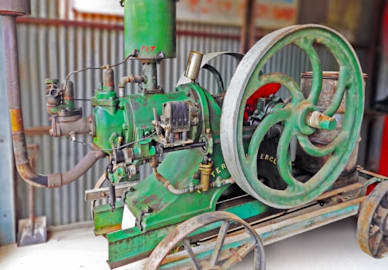Whilst photographing a Villiers Mk.I Midget for this article, I started to clean the area where the prefix and serial number are stamped, thinking it was a pre-War engine. It has the prefix CYZ and Serial No. 37594. I then noticed what looked to be a date stamped on the side of the cylinder flange: 2 – 10 – 45 (See Fig. 1.) and I started to wonder if this engine was built on the 2nd of October 1945.
If I am correct, it now looks as if prefixes were used until the end of 1945, when Villiers changed to Specification Numbers from 1946 onwards. The fact that there is no flywheel magneto means I have no number for it that might explain the date. This is not the first time I have seen a date stamped on a Villiers engine.

In 1941, Villiers produced two four stroke stationary engines called the ‘V’ engine. They were the 208cc Mk.20 and 256cc Mk.25. Fig. 2 shows the cast alloy oil sump of a Mk.20, and to the left of the oil filler cap, numbers and letters are stamped. The date is 16 – 10 – 45 (16th of October 1945) a similar style date to that on the Midget. I don’t know what the number 4057 signifies; CM 462 could be the prefix and serial number. Note “THE V MAGNETO” cast on the armature plate.
I have another Mk.I Midget on a Qualcast mower with the prefix CYZ and Serial No. 34250, and the magneto is 2PS 36369. The 2P means it is a two pole magneto, but I have no idea what the ‘S’ means. The last five numbers, I assume, is the serial number for the magneto; this engine looks to date from the late 1930s.
Engine Description
The one piece cylinder and head casting has three ports and a defector piston. On all other Villiers two-strokes of this type with a defector on the piston, it runs east/west (parallel to the crankshaft).
The Mk.I Midget is the odd man out; the defector on this piston runs north/south (at 90° to the crankshaft). So, instead of the transfer port being at the rear of the cylinder, it is on the same side of the crankcase as the flywheel magneto (See Fig. 3).

The exhaust port comes out on the drive side and turns 90° so it faces forward. The inlet pipe is part of the cylinder/head casting at the rear. The cylinder on my engine is tilted 15° forward and the inlet is tilted 15° downwards so the carburettor is vertical.

This type of engine was used in utility motorcycles, but it was also used by Qualcast in their mowers (See Fig. 4). On the front of the cylinder, just above the base flange, the following is cast:
VILLIERS
D5304
D5304 is the part number of the cylinder/head casting. Villiers looks to have started doing this in 1938/39 (See Fig. 5).
On the pre-War Mk.1 Midget fitted to my Qualcast mower, the following is cast in the same position:
X X X
O
Later Midgets
The 98cc Midget was first released in 1931 and was an immediate success; it was replaced in late 1948 by the Mk.2 and Mk.3 Midgets (with fan and cowling for cooling). From that time, the original Midget was known as the Mk.1.
I was recently sent a Villiers operating instructions and parts list for the Villiers Mark 2 and Mark 4 MIDGET two stroke engines as fitted to Ransomes motor mowers, dated January 1958. It turns out that when the Junior carburettor was replaced by the then new S12 carburettor in 1957, the Mk.2 became the Mk.4 Midget in the UK. Did the Mk.3 Midget become the Mk.5 at this time?

The standard Specification Number of the Mk.2 Midget produced at Ballarat, starting in 1954, was 100X. When the S12 carburettor replaced the Junior type, the standard Spec. No. became 400X, but it was still listed as a Mk.2 Midget.
Another thought has occurred to me; as the date stamped on both engines indicate October, were engines released in November or December 1945, as 1946 models, have Specification Numbers instead of the pre-War prefix?
If readers can help answer these questions, please email: ronwiley@bigpond.com
*Ron Wiley.





